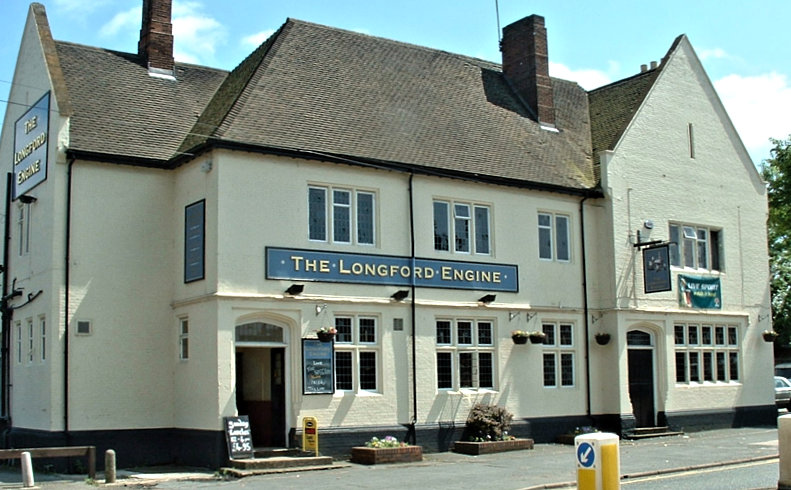Engine Inn, 270 Bedworth Road, Longford
| Alternative Addresses: | 27 Bedworth Road, Longford Road | ||
| These premises have been known by different names during their history: | FROM | TO | NAME |
| 1772 | 1807 | Fire Engine | |
| 1807 | 1886 | Engine Inn | |
| 1886 | 1985 | Old Engine Inn | |
| 1985 | c2008 | Canal Boat | |
| c2008 | Longford Engine | ||
 This seems to have been a reference to a local steam engine, perhaps for pit winding or water raising. A 'fire engine' at that time meant an external combustion engine, i.e. a steam engine powered by a fire, an atmospheric steam engine of the Newcomen type
In 1807 licensee John Parrish died, and in his will the pub is referred to as the "Engine Inn". (This information comes with thanks to Richard Jones, 6x great-grandson of John.) It is not yet certain how long before 1807 the pub's name changed from the Fire Engine.
In 1830 a noted prize-fight took place behind the Engine between John Adrian, licensee of the Windmill pub in Spon Street and a man called Betteridge, for £20 a side. It may have taken place here because it was outside the jurisdiction of the Coventry law.
In 1853 the licensee, Benjamin Bird, who was also a local farmer, purchased the City Arms in Earlsdon.
In 1906 the Engine was purchased by Phipps of Northampton for £2,000. In 1982 it was "a pleasant well decorated pub knocked into a single bar but with a separate games area".
Were Mrs Anne Bedder (1876 - 80) and Mrs Anne Edwards (1885 - 1908) the same person, and likewise John (1910) and James (1912) Brindley were probably the same?
This seems to have been a reference to a local steam engine, perhaps for pit winding or water raising. A 'fire engine' at that time meant an external combustion engine, i.e. a steam engine powered by a fire, an atmospheric steam engine of the Newcomen type
In 1807 licensee John Parrish died, and in his will the pub is referred to as the "Engine Inn". (This information comes with thanks to Richard Jones, 6x great-grandson of John.) It is not yet certain how long before 1807 the pub's name changed from the Fire Engine.
In 1830 a noted prize-fight took place behind the Engine between John Adrian, licensee of the Windmill pub in Spon Street and a man called Betteridge, for £20 a side. It may have taken place here because it was outside the jurisdiction of the Coventry law.
In 1853 the licensee, Benjamin Bird, who was also a local farmer, purchased the City Arms in Earlsdon.
In 1906 the Engine was purchased by Phipps of Northampton for £2,000. In 1982 it was "a pleasant well decorated pub knocked into a single bar but with a separate games area".
Were Mrs Anne Bedder (1876 - 80) and Mrs Anne Edwards (1885 - 1908) the same person, and likewise John (1910) and James (1912) Brindley were probably the same? | |||
LICENSEES:to 1807 John Parrish 1807 - 1840 Jeremiah Dufkin Parrish (son of John, above) 1840 Thomas Parish (son of Jeremiah, above. Information courtesy of Richard Jones, 4x great-grandson of Jeremiah.) 1850 Benjamin Bird (see also Queens Arms, Cross Cheaping and The City Arms, Earlsdon) 1851 Mark West 1863 Joseph Hollyoak 1866 Thomas Warren 1868 Henry Warren 1871 - 1874 Francis Bedder 1876 - 1880 Mrs Anne (Annie) Bedder 1885 - 1908 Mrs Anne Edwards | |||
| Previous page: Empire Vaults | This page: Engine Inn | Next page: Establishment |